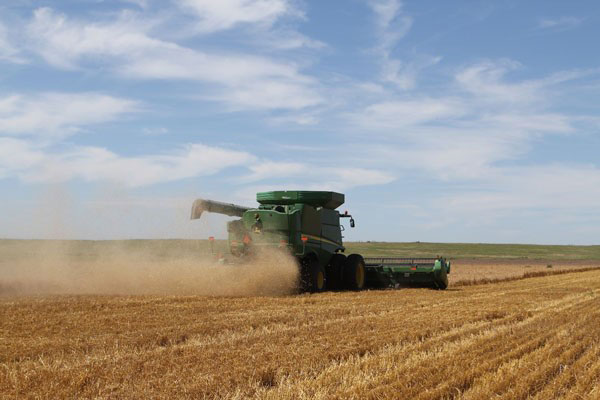Multiple herbicide-resistant weeds are a threat to crop production in Kansas. Kochia, Palmer amaranth, and waterhemp are the most problematic weeds in the State due to their ability to evolve resistance and their capacity to produce many seeds. Also, downy brome, cereal rye, Italian ryegrass, and jointed goatgrass are other troublesome grass weeds, especially in winter wheat. Effective weed control strategies that target the weakest points of the weed’s life cycle are needed. These strategies include the prevention of seedling emergence, prevention of seedling survival, and prevention of seed production and dispersal. This article focuses on the prevention of seed dispersal.
Weed seed retention at harvest and potential for harvest weed seed control
Weeds persist through time because of the soil seedbank in growers’ fields. A single isolated female Palmer amaranth plant can produce 600,000 seeds, while an isolated kochia plant can produce more than 100,000 seeds. Once dispersed, these seeds enter the soil seedbank and increase potential weed pressure in the following growing seasons. Previous research showed that, without new seed inputs, seedbanks could be reduced to a small size in just a few years. Therefore, targeting weed seeds at crop harvest represents an opportunity to take proactive action against future weed problems. During harvest, weed seed has either already fallen or is collected by the combine, mixed with the chaff, and redistributed on the soil surface.
Harvest weed seed control (HWSC) practices target weed seeds present on the plant at harvest. They are more effective when weeds have retained a large proportion of seed on the plant at a height that will be collected during harvest. In the Great Plains, downy brome, cereal rye, and jointed goatgrass have 76% seed retained above the harvest cutting height at wheat harvest (6 inches and above) and have intermediate potential for HWSC. Palmer amaranth, common lambsquarters, kochia, and green foxtail have 91, 90, 100, and 94% seed retained and have a very high potential for HWSC.
Weed seed destruction
Destroying weed seeds in the chaff is a potential system for reducing the number of potentially herbicide-resistant weed seeds returned to the soil seed bank in a field. The weed seed in the chaff goes through a mill and gets pulverized, then spread back on the field. Australian farmer Ray Harrington developed the Harrington Seed Destructor (HSD) in 2005. It is a trailer-mounted cage mill with chaff and straw transfer systems powered by a separate diesel motor. However, constraints in using the tow-behind version of the HSD led to the development of the integrated Harrington Seed Destructor (iHSD), where the impact mill is integrated into the rear of the combine, powered by the combine instead of a separate diesel engine (Figure 1). Several companies have developed mills attached to a combine. The most easily accessed in North America is the Redekop mill, manufactured in Canada. Testing of the seed mills in North America suggests that the systems are highly effective at destroying weed seeds that pass through the combine.
In Australia, seed destruction for wild oats, brome grass, rigid ryegrass, and wild radish were 99, 99, 95, and 93%, respectively. Research conducted on soybean in the United States found less than 1% seed survival for Palmer amaranth, morningglory species, johnsongrass, barnyardgrass, hemp sesbania, prickly sida, velvetleaf, sicklepod, giant ragweed, common lambsquarters, and weedy rice. Only common cocklebur had 3% seed survival. In the Great Plains region, weed seed destruction percentages were at least 98% for downy brome, feral rye, and jointed goatgrass, suggesting that HWSC could be implemented as an integrated strategy for winter annual grass management in winter wheat cropping systems of the Central Great Plains.

Figure 1. A combine with a weed seed control unit is used during wheat harvest. Photo by Jeremie Kouame, K-State Research and Extension
References
Walsh et al. (2018), Schwartz-Lazaro et al. (2017) .
Jeremie Kouame, Weed Scientist, Agricultural Research Center – Hays
jkouame@ksu.edu
Anita Dille, Weed Ecologist, Agronomy Department, Kansas State University
dieleman@ksu.edu
Sarah Lancaster, Weed Management Specialist
slancaster@ksu.edu